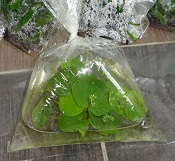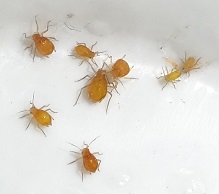| Home | Nature Weekly Index |
12 July 2015 | Aphids on Frogbit |
 On 20 June, I introduced a new floating plant into my mini aquarium. The other floating
plant, Trapa natans (Water Chestnut) that I put in on 24 May did not work out well.
It started dying 2 weeks later and I had to remove it. When I brought the replacement floating plant back in June, I did not have
a name for it and was in no hurry to find out.
On 20 June, I introduced a new floating plant into my mini aquarium. The other floating
plant, Trapa natans (Water Chestnut) that I put in on 24 May did not work out well.
It started dying 2 weeks later and I had to remove it. When I brought the replacement floating plant back in June, I did not have
a name for it and was in no hurry to find out.

 Last week, I started seeing many tiny light brown particles on the surface of its floating leaves. At first, I thought they were
merely the leftover dried fish food that accidently dropped on the leaves during feeding. When I finally decided to take a closer
look, to my horror, they were all little aphids. It had never crossed my mind to look out for aphids on aquatic plants though I had
seen them frequently on my potted plants.
Last week, I started seeing many tiny light brown particles on the surface of its floating leaves. At first, I thought they were
merely the leftover dried fish food that accidently dropped on the leaves during feeding. When I finally decided to take a closer
look, to my horror, they were all little aphids. It had never crossed my mind to look out for aphids on aquatic plants though I had
seen them frequently on my potted plants.
After searching the Internet, I figured the identity of this new floating plant should be Hydrocharis morsus-ranae, commonly known as Frogbit. It is a free floating plant. Its heart-shaped leaves are about 4 centimetres in diameter. As for the aphid, it was probably the Waterlily Aphid (Rhopalosiphum nymphaeae). Its colour was described as reddish-brown to dark olive.

 Since I now knew that they were aphids, I was quite
eager to remove them before the Frogbit succumb to their attack. It was much easier to remove them compared to those on land
plants. They were all exposed on the surface of the leaves. All I need to do was to fish out all the Frogbit from the tank into
a pail with water, swap the aphids into the water and pour the water away thereafter. Apparently, the fishes were not keen to eat
aphids. Fortunately, the aphids had come to light early. If I did not discover the aphids, the plant may eventually get kill by
them and I might think that leftover fish food on leave surface was bad for plants.
Since I now knew that they were aphids, I was quite
eager to remove them before the Frogbit succumb to their attack. It was much easier to remove them compared to those on land
plants. They were all exposed on the surface of the leaves. All I need to do was to fish out all the Frogbit from the tank into
a pail with water, swap the aphids into the water and pour the water away thereafter. Apparently, the fishes were not keen to eat
aphids. Fortunately, the aphids had come to light early. If I did not discover the aphids, the plant may eventually get kill by
them and I might think that leftover fish food on leave surface was bad for plants.
The white materials by the side of the aphids were the casts left by the aphids after their moulting. In addition to sucking of fluid from plants, aphids are also a carriers of plant diseases.
Yesterday, when I did another check, the aphids had returned on the leaf surface and I did another round of clean up. Hopefully, I will be able to remove them permanently.